We know that SEO is no longer a new term for marketers since there are so many companies and departments related to search engine marketing in the advertising industry, and also the corresponding training business. Try to search “SEO service” on the internet, you will see a full screen of related services available online. Even you don’t want to pay for the service fee and decide to do it by yourself, self-study materials are also available online, various SEO marketing blogs and videos. But these materials are mixed with both good and bad quality tutorials, and even the years old blogs. These materials will definitely mislead SEO beginners.
Therefore, here is an easy-to-understand introduction from my personal experience, this information is suitable for SEO beginners, and also suitable for SEO experts who have not practiced in SEO market for a long time, as well as those who have a misunderstanding with SEO.
Network, Website and Search Engine
If we compare the entire Internet to the universe, then the website is a planet wandering in it. Each planet has its own name, called the website domain, such as seomarlin.com. Unlimited pages can be created under each domain and have their own address (url). For example, byo.media/blog, byo.media/blog/12356, etc., because of their linking relationship, eventually forming a huge network.
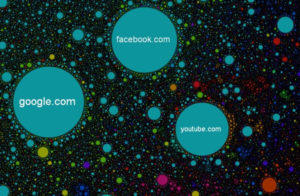
However, the online world is too complicated for us, and it is difficult for us to find what we are looking for. We need a librarian to help us sort and organize all the information, and he can know our intentions only through a few of our words. But before that, the librarian has a very heavy task to do: he needs to travel the entire online world and index all the content.
The method for librarians to travel through the network is pretty simple. It is to find links from one station to another, and use these links as the bridges to discover pages and websites. Since this way of walking around the Internet is so much like a spider crawling on the web, so people call the librarian a crawler or a spider.
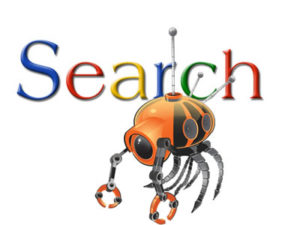
After using bridge and walking through all the pages and websites that can be found, the crawler organizes all the known information and ranks it with its own set of methods to meet our query needs as much as possible. This “method” is called “algorithm”, which is the core and most mysterious part of the entire search engine technology.
Due to the existence of different search engines, the crawlers will also be different, and the algorithm will be very different from each other. The content that appears on the Search Engine Results Page (SERP) after the search is also impossible to be the same or say the site ranking is also impossible to be the same.
The Goal of SEO
From an SEO perspective, there are usually two types of websites. One is for humans to read, and the other is for search engines to read (which are crawled by robots). On one hand, a human reads a website and fell the site is well designed and beautiful. But on the other hand, the crawler may feel the website structure, code, traffic, etc is pretty bad at the same time. In this way, the site will be defined as an “unfriendly” site, which will result in poor rankings on SERP. So the job of SEO is to make a website “friendly” enough for crawlers, and turn a “human-like” website into a site that both human and machine all likes website.
To put it in-depth, through various guesses, practices, and summaries of the search algorithm, the ultimate goal is to display the target page with a high organic search ranking on the result page of the targetted keyword.
Explain it in a few words first:
Organic Search Results: different from PPC (Pay Per Click) paid search results, the organic search results are those ones that do not require any payment on the results page.
Targeted Keywords: the keywords that appear in the user’s search query when you want your target page to appear in SERP.
Landing Page: the page you want users to land on when clicking on your SERP link.
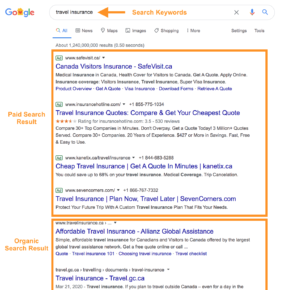
It can be seen from the figure above, the goal of SEO is to place your page as high on the organic search result as possible.
Even the SEO is called search engine optimization, it does not mean optimizing search engine, it means optimizing your own site and making it more popular with search engines.
SEO Indicators
To measure the performance of SEO, the most common indicator is keyword ranking. So the question is, what is the difference between first and second? What is the difference between the first page and the second page? In order to narrow this gap, how much time and money will worth to try it?
Here we are going to introduce a concept, click-through rate (CTR):
CTR = Clicks/Impressions
Clicks represent the number of clicks, and Impression represents the number of times your site was searched, but not necessarily to be clicked, or we can call it the number of exposures. It is not difficult to judge that the higher the ranking is, the greater the number of exposures. The exposure on the first page of the search results page is definitely greater than the second page.
Then what about the clicks? Let ’s take a look at an earlier Google survey, the heat map that tracks user eyeballs and their clicks:
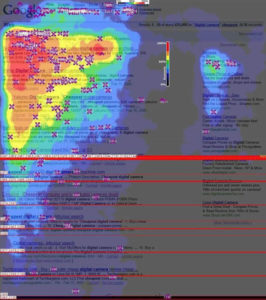
The dark red area in the upper left corner proves that the user always notices the top-ranked search results first, and the density of clicks (purple X) indicates that the user likes to click on the first thing they noticed. It can be proved that the search ranking is directly related to the clicks and impressions.
The Gap Between Rankings
Brand Keywords vs Non-Brand Keywords
The search volume of brand keywords usually represents the popularity of a brand, and the searchers of non-brand keywords are the objects that your brand needs to attract. For example: HP notebook (brand) vs notebook (non-brand).
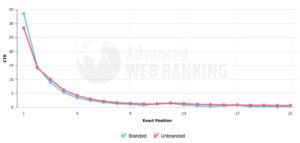
The x-axis in the figure is the click-through rate, and the y-axis is the ranking. The decline of brand keywords (blue), from 1 to 2 is most obvious, but the meaning of non-brand words (red) means more to the companies. There’s about 30% CTR in the first place, about 15% CTR in the second place, and 10% CTR in the third place. The CTR of the 9th-10th place is almost the same as the CTR of the second page: 2%. It can be seen that the value of the first place is much greater than the second.
In addition, considering that the proportion of navigation searches in search engines is high, users often search for brand terms in order to visit their websites. At a glance, it is not difficult to understand why the click-through rate of brand keywords is usually slightly higher than the non-brand keywords.
Broad Keywords vs Long Tail Keywords
Broad keywords are relatively short (short tail keywords), with high traffic, high competition, and low conversion; long tails have long-phrase lengths, low traffic, low competition, and high conversion.
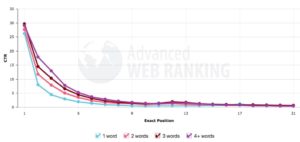
In this comparison, it is clear to see that the longer the phrase, the smaller the CTR drops. This is also because the long-tailed keywords (purple) have less competition and fewer results. If we look at long-tail keywords from a macro perspective, accumulating small all traffic from various long-tail keywords will eventually form large traffic.
Usually, the results that are most in line with the user’s ideas have already appeared on the first page.
To sum up, no matter what kind of search terms, you can always see the huge advantages of the top 3 ranks in clicks, exposures, and CTR.
SEO Benefits
Although SEO works slowly, its biggest advantage is that there is no “net media spend”, you do not need to pay Google any advertising costs in your promotional activities. For example, taking the monthly budget of 2K as an example to do paid search ads, the cost after one year is 24k. And because of the diminishing return channel, in order to ensure the same effect, the cost will eventually be higher than this number at the end. The benefits of SEO are quite the opposite, the longer the traffic, the higher the quality is. Later, SEO alone can support the all the traffic from the entire website and gain large free benefits.
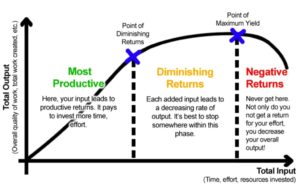
If your brand intends to operate for a year or more, starting SEO early is actually saving you money. And if you want to see immediate results, try a paid search (SEM).
What does SEO need to do?
After figuring out what SEO is, we took the actual work as the starting point and divided the optimization work into “in-site optimization” and “off-site optimization”.
In-Site Optimization
An optimization operation that can be completed in the site. These operations include but not limited to:
- site structure optimization
- keyword research and layout
- page content writing
- meta tag optimization
- alt tag optimization
- website speed optimization
- schema optimization
- sitemap.xml optimization
- robots.txt optimization
- inner chain optimization
- 301, 404 and other jumps
- etc.
Although the above operation is slightly troublesome, whether it is a big change or a minor change, it is done on its own website, so it is still relatively easy. The purpose of those is to allow crawlers to quickly and accurately retrieve and include pages on the website within a limited time.
Off-Site Optimization
Off-site optimization may be more difficult to control since it needs help from the outside to improve your site’s ranking. You will not only need to do the link “weight” but also a concept of “mentioned”, which will be particularly important in Google ranking.
Briefly introduce the “weight”. Originally Google had a rating system for each site, also known as the PR (Page Rank) value. Rate from 0 to 10 points, the higher the score, the higher the website weight, and the higher the score, the higher the score is the harder it is to increase. The PR value of a website mainly depends on its backlinks, which are the links from other website pages to your pages. The greater the number of links to your page, or the better the quality is, the higher the weight of your page, which will cause the PR to rise and organic ranking increases.
Then the question comes, everyone knows the “quantity” of links, but how to understand the “quality”?
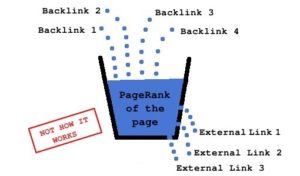
Imagine your website as a bucket, and the “weight” is the water in the bucket. The more water, the higher the weight. Imagine that the outer chain is a water pipe that points to your bucket and continuously transporting water. The more water pipes, the faster the water will increase, and the water in the bucket will increase accordingly, so the weight will increase. At the same time, external links on your page are like holes in the bottom of the bucket. The more water you have, the more stable and longer the water flowing out of the hole, resulting in a better “quality” of this water.
In summary, the source of your page weight depends on the weight of the sites that link to you and others. The higher their weight, the higher the weight of “leaking” of your page, so the more the external links are, the better the site is.
On the other hand, if your website content or business is “mentioned” elsewhere, it is also good for ranking. Although the weight does not travel on social media such as Facebook, but once a keyword is forwarded in large numbers because of an event, the link related to the entry seen in SERP can often see your target page. This is particularly common in Google, combined with the “weight” feature, the above phenomenon is also often used as a means of network public relations. Therefore, keeping the water in the bucket and maintaining a good weight is one of the important themes of optimization outside the site.
In addition, in local SEO, it is of extraordinary significance to modify the information (often excluding URLs) included in a large number of directory sites and add local searches to businesses. In Google, the top three local rankings on SERPs can be included in the “Local Block” to directly highlight corporate information in Google Maps. In this case, ranking from fourth to third is usually a qualitative leap. Especially on the new version of the box is displayed directly in the center of the SERP.
Old:
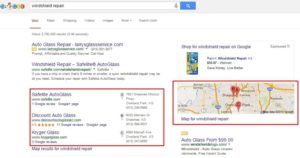
New:
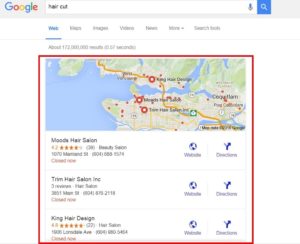
Common SEO Fees and Service Processes
Since each project has different requirements for SEO, and the project and industry itself are very different, it is difficult to give an accurate SEO industry valuation here. But the following questions can help you sort out the difficulty of SEO for your project and whether it is necessary to conduct SEO
- How do your guests find your services or products in your industry?
- Is your service or product limited to local or international scope?
- Do you need a multi-language market or English only market?
- How much search volume do you want for the keywords in the corresponding area?
- Search for the keywords you are interested in and see if your industry is highly competitive? If you do SEO, is there a chance to make yourself in the top 3?
- Search your brand, is there any negative information?
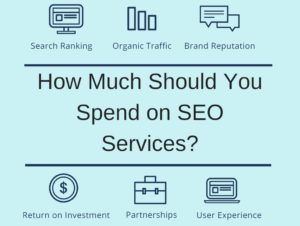
In addition, provide the common process of SEO services for reference:
- Unify the goals of both parties and ensure for the same appeal
- A simple evaluation and quotation of the website by the SEO marketing company
- Both parties sign the agreement and pay the prepayment
- The SEO company conducts a comprehensive review of the website and cooperates with the employer to repair it one by one
- Competitive product analysis based on competition
- Service officially started
- Provide monthly reports, including the performance of core vocabulary and corresponding traffic performance
- The employer pays for the service according to the agreement
In actual operation, the service processes of SEO marketing companies will be somewhat different, but the goals should be measured with the initially agreed indicators to achieve the greatest protection for the benefit of both parties.
Conclusion:
A few years ago, Google introduced an entry-level explanation of SEO, but the actual situation has long been different.
This article mainly helps SEO beginners to clarify what SEO is about, and gives a superficial explanation from the perspective of SEO operation classification. In fact, there are still many concepts not mentioned in this article yet.
Learning SEO is something that needs to keep pace with the times. Yesterday, the correct SEO optimization method was recognized. Today, an algorithm update of the search engine may lead your correct method to the wrong method. If you use a tool such as Rank Ranger to monitor your target keywords, you will find that they are floating up and down happily every day like the stock market, and then, occasionally, there will be a big jump or a sudden jump, which will keep you busy.



